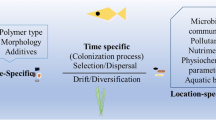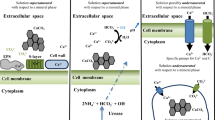Abstract
Electron microscopic, spectroscopic, and geochemical study of Middle Ordovician shamosite, Wenlockian calcite, and Lower Carboniferous siderite nodules revealed the presence of organic matter and traces of microbial organisms involved in the formation of iron oxides and hydroxides and mineralized microbial films. The structure and composition of the films show high similarity to mineralized glycocalyx, which is a product of bacterial metabolism. Diversity of the framboidal micropyrite and bacteriomorph structures in size and shape indicates the formation of nodules under anoxic bottom conditions and abundance of sulfate-reducing, iron-reducing, and iron-oxidizing bacteria. The presence of authigenic minerals in the nodules, which is atypical for sedimentary rocks, suggests the influence of bottom gas–fluid seeps and, therefore, local hydrosulfuric contamination, fluctuations in salinity, and intensive development of bacterial communities.




Similar content being viewed by others
REFERENCES
Alekseeva, T.V., Sapova, E.V., Gerasimenko, L.M., and Alekseev, A.O., Transformation of clayey minerals under influence of alcophilic cyanobacterial community, Mikrobiologiya, 2009, vol. 78, no. 6, pp. 816–825.
Antoshkina, A.I., Ryabinkina, N.N., and Valyaeva, O.Yu., Genesis of sideritic nodules from Lower Carboniferous siliciclastic strata of the Subpolar Urals, Litol. Polezn. Iskop., 2017, no. 2, pp. 130–144.
Bagdasarova, M.V., On the mineralogy of terrigenous deposits of the Lower Carboniferous of the Subpolar Urals, in Fatsii i usloviya formirovaniya neftegazoproizvodyashchikh svit (Facies and Conditions of the Formation of Oil-and-Gas-bearing Formations), Moscow: Nauka, 1966, pp. 64–92.
Bortnikov, N.S., Novikov, V.M., Gendler, T.S., Piloyan, G.O., Zhegallo, E.A., and Boeva, N.M., Biomineralization, magnetic and thermal properties of a ferriferous nodule from the laterite bauxite deposits of Baolok in southern Vietnam, Dokl. Ross. Akad. Nauk Ser. Geokhim., 2011, vol. 441, no. 6, pp. 788–791.
Christensen, N.B., Stable isotope geochemistry of siderite concretions from Jurassic sedimentary rocks on Bornholm (Denmark), Bull. Geol. Soc. Denmark, 1995, vol. 42, pp. 47–56.
Cramer, B.D. and Saltzman, M.R., Fluctuations in epeiric sea carbonate production during Silurian positive carbon isotope excursions: A review of proposed paleoceanographic models, Palaeogeogr., Palaeoclimatol. Palaeoecol., 2007, vol. 245, pp. 37–45.
Duguid, S.M.A., Keyser, T.K., James, N.P., and Rankey, E.S., Microbes and ooids, J. Sediment. Res., 2010, vol. 80, pp. 236–251.
Ellwood, B.B., Chrzanowski, T.H., Hrouda, F., Long, G.J., and Buhl, M.L., Siderite formation in anoxic deep-sea sediments: A synergetic bacteria controlled process with important implications in paleomagnetism, Geology, 1988, vol. 16, no. 11, pp. 980–982.
Ferretti, A., Ooidal ironstones and laminated ferruginous deposits from the Silurian of the Carnic Alps, Austria, Boll. Soc. Paleontol. Ital., 2005, vol. 44, no. 3, pp. 263–278.
Flügel, E., Microfacies of Carbonate Rocks: Analysis, Interpretation and Application, Berlin: Heidelberg–Springer, 2004.
Folk, R.L., Nannobacteria and the formation of framboidal pyrite, J. Earth Syst. Sci., 2005, vol. 114, no. 3, pp. 369–374.
Franceschelli, M., Puxeddu, M., and Carta, M., Mineralogy and geochemistry of Late Ordovician phospate-bearing oolitic ironstones from NW Sardinia, Italy, Mineral. Petrol., 2000, vol. 69, nos. 3–4, pp. 267–293.
Fredrickson, J.K., Zachara, J.M., Kennedy, D.W., Dong, H., Onstott, T.C., Hinman, N.W., and Li, S.M., Biogenic iron mineralization accompanying the dissimilatory reduction of hydrous ferric oxide by a groundwater bacterium, Geochim. Cosmochim. Acta, 1998, vol. 62, pp. 3239–3257.
Gerasimenko, L.M. and Ushatinskaya, G.T., Cyanobacteria, cyanobacterial communities, mats, and biofilms, in Bakterial’naya paleontologiya (Bacterial Paleontology), Moscow: Paleontol. Inst. Ross. Akad Nauk, 2002, pp. 36–46.
Halas, S. and Chlebowski, R., Unique siderite occurrence in Baltic Sea: A clue to siderite–water oxygen isotope fractionation at low temperatures, Geol. Quart., 2004, vol. 48, no. 4, pp. 317–322.
Iskopaemye bakterii i drugie mikroorganizmy v zemnykh porodakh i astromaterialakh (Fossil Bacteria and Other Microorganisms in Terrestrial Rocks and Astromaterial), Rozanov, A.Yu. and Ushatinskaya, G.T., Eds., Moscow: Paleontol. Inst. Ross. Akad Nauk, 2011.
James, H.L., Chemistry of the Iron-rich Sedimentary Rocks: Chapter W: Data of Geochemistry, Fleischer, M., Ed., Washington, DC: US Govern. Print. Office, 1966.
Johnson, C.M., Ludois, J.M., Beard, B.L., Beukes, N.J., and Heimann, A., Iron formation carbonates: Paleoceanographic proxy or recorder of microbial diagenesis?, Geology, 2013, vol. 41, no. 11, pp. 1147–1150.
Khipeli, R.V., Patterns of the formation of Paleozoic organogenic buildups and reservoirs connected with them in the southern Khoreiverskaya Depression, Candidate’s Dissertation on Geology and Mineralogy, Syktyvkar, 2005.
Lovley, D.R. and Phillips, E.J.P., Novel mode of microbial energy metabolism: Organic carbon oxidation coupled to dissimilatory reduction of iron or manganese, Appl. Environ. Microbiol., 1988, vol. 54, pp. 1472–1480.
Männik, P. and Martma, T., Llandovery–Wenlock boundary in the Subpolar Urals, Ichthyolith Is. Sp. Syktyvkar Geoprint, 2000, no. 6, pp. 64–67.
Merinero, R., Lunar, R., Martinez-Frias, J., Somoza, L., and Diaz-del-Rio, V., Iron oxyhydroxide and sulphide mineralization in hydrocarbon seep-related carbonate submarine chimneys, Gulf of Cadiz (SW Iberian Peninsula), Mar. Petrol. Geol., 2008, vol. 25, pp. 706–713.
Merkushova, M.Yu. and Zhegallo, E.A., Biomorphic structures in rich iron ores Kma (based on the results of electron microscopic examination, Vest. Voronezh. Gos. Univ. Ser. Geol., 2016, no. 2, pp. 150–154.
Miot, J., Benzerara, K., Morin, G., Kappler, A., Bernard, S., Obst, M., Ferard, C., Skouri-Panet, F., Guigner, J.-M., Posth, N., Galvez, M., Brown, G.E., Jr., and Guyot, F., Iron biomineralization byanaerobic neutrophilic iron-oxidizing bacteria, Geochim. Cosmochim. Acta, 2009, vol. 73, no. 3, pp. 696–711.
Munnecke, A., Calner, M., Harper, D.A.T., and Servais, T., Ordovician and Silurian sea-water chemistry, sea level, and climate: A synopsis, Palaeogeogr., Palaeoclimalol., Palaeoecol., 2010, vol. 296, pp. 389–413.
Naimark, E.B., Eroshchev-Shak, V.A., Chizhikova, N.P., and Kompantseva, E.I., Interaction of clayey minerals with microorganisms: A review of experimental data, Zh. Obshch. Boil., 2009, vol. 70, no. 2, pp. 155–167.
Novikov, V.M., Bortnikov, N.S., Boeva, N.M., Zhukhlistov, A.P., Zhegallo, E.A, Novakova, A.A., and Sobo-leva, S.V., Biogenic nanominerals of iron oxides in weathering crusts of basalts of continental marginal areas of eastern Asia, using an example of Far East Russia and Vietnam: Paper 2. Hematite, Vest. Voronezh. Gos. Univ. Ser. Geol., 2016, no. 4, pp. 23–30.
O’Reilly, S.S., Mariotti, G., Winter, A.R., Newman, S.A., Matys, E.D., McDermott, F., Pruss, S.B., Bosak, T., Summons, R.E., and Klepac-Ceraj, V., Molecular biosignatures reveal common benthic microbial sources of organic matter in ooids and grapestones from Pigeon Cay, the Bahamas, Geobiology, 2017, vol. 15, no. 1, pp. 112–130. doi 10.1111/gbi.12196
Pacton, V., Ariztegui, D., Wacey, D., Kilburn, M.R., Rollion-Bard, C., Farah, R., and Vascoucelos, C., Going nano: A new step towards understanding the processes governing fresh water ooid formation, Geology, 2012, vol. 40, no. 6, pp. 547–550.
Puchkov, V.N., Geologiya Urala i Priural’ya (aktual’nye voprosy stratigrafii, tektoniki, geodinamiki i metallogenii) (Geology of the Urals and Fore-Urals: Topical Questions of Stratigraphy, Tectonics, Geodynamics and Metallogeny), Ufa: Dizain PoligrafServis, 2010.
Roh, Y., Zhang, C.-L., Vali, H., Lauf, R.J., Zhou, J., and Pheps, T.J., Biogeochemical and environmental factors in Fe biomineralization: Magnetite and siderite formation, Clays Clay Miner., 2003, vol. 51, no. 1, pp. 83–95.
Ryabinkina, N.N., Usloviya formirovaniya i perspektivy neftegazonosnosti vizeiskogo terrigennogo kompleksa Pechorskogo basseina (Conditions of the Formation and Prospects of the Oil-and-Gas Presence in he Visean Terrigenous Complex of the Pechora Basin), Ekaterinburg: Ural. Otd. Ross. Akad Nauk, 2006.
Saґnchez-Romain, M., Fernandez-Remolar, D., Amils, R., Sanchez-Navas, A., Schmid, T., Martin–Uriz, P.S., Rodrıguez, N., McKenzie, J.A., and Vasconcelos, C., Microbial mediated formation of Fe-carbonate minerals under extreme acidic conditions, Sci. Rep., 2014. doi 10.1038/srep04767
Scotese, C.R., Paleogeographic Atlas, Calgary: Paleomap, Project., 2000.
Shebolkin, D.N. and Mannik, P., Wenlockian deposits of the southern part of the Chernyshev Ridge (Timan–Severouralsk Region), Litosfera, 2014, no. 1, pp. 33–40.
Strakhov, N.M., Osnovy teorii litogeneza (Fundamentals of the Theory of Lithogenesis), vol. 1: Tipy litogeneza i ikh razmeshchenie na poverkhnosti Zemli (Types of Lithogenesis and Accommodation on the Earth’s Surface), Moscow: Akad. Nauk SSSR, 1960.
Summons, R.E., Bird, L.R., Gillespie, A.I., Pruss, S.B., Roberts, M., and Sessions, A.L., Lipid biomarkers in ooids from different locations and ages: Evidence for a common bacterial flora, Geobiology, 2013, vol. 11, no. 5, pp. 420–436.
Suttner, T.J. and Kido, E., Ordovician and Silurian times: Global events and biodiversity, Mem. Geol. Soc. Ind., 2011, no. 78, pp. 29–68.
Tomas, S., Homann, M., Mutti, M., Amour, F., Christ, N., Immenhauser, A., Agar, S.M., and Kabiri, L., Alternation of microbial mounds and ooid shoals (Middle Jurassic, Morocco): Response to paleoenvironmental changes, Sedim. Geol., 2013, vol. 294, pp. 68–82.
Van Houten, F.B. and Bhattacharyya, D.P., Phanerozoic oolitic ironstones—geologic record and facies model, Ann. Rev. Earth Planet. Sci., 1982, vol. 10, no. 1, pp. 441–457.
Voigt, T., Gaupp, R., and Rohling, H-G., Lake deposits of the Early Triassic Buntsandstein in central Germany: Type localities of oolites and stromatolites, in Proceedings of the 5th International Limnogeological Congress, Constanza, 2011, pp. 191–211.
Vu, B., Chen, M., Russell, J., Crawford, R.J., and Ivanova, E.P., Bacterial extracellular polysaccharides involved in biofilm formation, Molecules, 2009, vol. 14, pp. 2535–2554.
Woodland, B.G. and Stenstrom, R.C., The occurrence and origin of siderite concretions in the Francis Creek Shale (Pennsylvanian) of northeastern Illinois, in Mazon Creek Fossils, Nitecki, M.H., Ed., New York: Academic Press, 1979, pp. 69–103.
Wu, Z., Yuan, L., Jia, N., Wang, Yu., and Sun, L., Microbial biomineralization of iron seepage water: Implication for the iron ores formation in intertidal zone of Zhoushan Archipelago, East China Sea, Geochem. J., 2009, vol. 43, pp. 167–177.
Yoshida, M., Khan, I.H., and Ahmad, M.N., Remanent magnetization of oolitic ironstone beds, Hazara area, Lesser Himalayan thrust zone, northern Pakistan: Its acquisition, timing, and paleoenvironmental implications, Earth Planets Space, 1998, vol. 50, pp. 733–744.
Yudovich, Ya.E., Maidl’, T.V., Andreev, G.I., Korel’skii, V.P., Entsova, F.I., Kuz’kokova, N.N., Pavlov, L.P., Silaev, V.I., and Chermnykh, V.A., Geochemistry of reference sections of the Lower Carboniferous and Permian on the Kozhim River (Polar Urals), Tr. Inst. Geol. Komi Fil. Akad. Nauk SSSR, 1979, vol. 28 (Lithology and Geochemistry of Paleozoic Formations of the Northern Urals and Pai-Khoi), pp. 3–36.
Yudovich, Ya.E. and Shulepova, A.N., Oolitic iron ores in Ordovician limestones of the Pechora Urals, in Geologiya i poleznye iskopaemye Severo-Vostoka Evropeiskoi chasti SSSR: Ezhegodnik-1972 (Geology and Mineral Resources of the Northeast of the European Part of the USSR: Yearbook-1972), Syktyvkar: Inst. Geol. Komi Fil. Akad Nauk SSSR, 1973, pp. 21–27.
Yudovich, Ya.E., Yudin, V.V., Shulepova, A.N., and Khoroshilova, L.A., New data on oolitic iron ores in the Middle Ordovician of the Northern Urals, in Litologiya i usloviya obrazovaniya dokembriiskikh i palezoiskikh otlozhenii Urala (Lithology and Conditions of the Formation of Precambrian and Paleozoic Deposits of the Urals), Ekaterinburg: Ural. Nauchn. Tsentr Akad. Nauk SSSR, 1981, pp. 26–34.
Yushkin, N.P., Silaev, V.I., Zharkov, V.A., Filippov, V.N., Lyutoev, V.P., and Simakova, Yu.S., Mesozoic coprolites: mineralogical–geochemical properties and relation to the prediction of the phosphate content, in Problemy mineralogii, petrografii i metallogenii (Problems of Mineralogy, Petrography, and Metallogeny), Perm: Perm. Gos. Univ., 2013, no. 16, pp. 26–52.
Zholnovich, V.A., Framboidal units of pyrite in the deposits of modern lakes of he humid zone, EVMO, 1990, vol. 4, pp. 39–43.
ACKNOWLEDGMENTS
The present work was supported by the Program of the Russian Academy of Sciences “Evolution of the Organic World and Planetary Processes” (Subprogram 2) and by the Russian Foundation for Basic Research (Ural Branch), project no. 15-18-5-47.
Author information
Authors and Affiliations
Corresponding author
Additional information
Translated by A. Panyushkina
Rights and permissions
About this article
Cite this article
Antoshkina, A.I. Bacteriomorph Structures in Nodules, a Characteristic of Euxinic Conditions of Nodule Formation. Paleontol. J. 52, 1114–1125 (2018). https://doi.org/10.1134/S0031030118100040
Received:
Published:
Issue Date:
DOI: https://doi.org/10.1134/S0031030118100040




